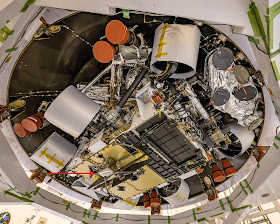Engineers at NASA's JPL have been busy getting the Mars Rover, Perseverance, ready for the start of its journey to Mars landing at Jezero Crater on 18 February 2021. The crater is some 45km in diameter and Perseverance will land on the flat floor of the crater just east of the ancient river delta.
The rover's mission is to look for signs of past life, collect rock and soil samples, and cache them for possible return to Earth at a later date in a joint venture with the European Space Agency (ESA).
 |
NASA's Hubble Space Telescope took this photo of Mars in July 2018 near its closest approach to Earth since 2003 - 36.9 million miles.The two Moons of Mars are Phobos (right) and Deimos (left).
|
 |
| Jezero crater lies within the small circle near the centre of the photograph. Crater not visible. Photo Mars Orbiter Mission 2014 |
 |
| Perseverance landing ellipse in Jezero crater |
 |
| The name plate attached to Perseverance's robotic arm |
The laser-etched titanium plate weighs 104g and measures 43cm long by 8.26cm wide and was cut using a water-jet. The surface was coated with black thermal paint before a computer-guided laser generated the name 'Perseverance' by ablating the surface.
The name plate acts as a rock and debris shield to protect the cables which carry power and data to the computer in the body of the rover to the actuators in the arm. Power is also carried to the instruments and drill in the turret.
(Photo and details courtesy NASA/JPL-Caltech
)
 |
| Perseverance gets its flight wheels which are 52.5cm in diameter. The wheels are re-engineered versions of Curiosity's and have twice as many treads, slightly curved instead of chevron |
 |
| The protective antistatic foil will be removed before launch. The spokes are titanium. |
 |
| Perseverance during mass properties measurements |
Precision mass properties measurements are crucial to to a safe landing on Mars, ensuring the spacecraft travels accurately throughout its journey and has a successful entry, descent and landing.
On a rover turnover fixture the Perseverance’s centre of gravity is determined relative to its x-axis (tail to front) before moving Perseverance to a spin table the surface of which sits on a spherical air bearing that levitates on a thin layer of nitrogen gas. The centre of gravity of is then determined relative to Perseverance's z-axis (top to bottom) and the y-axis (left to right). The engineers then rotate the rover slowly back and forth calculating the imbalance in its mass distribution.
After analysis of the data, 6.27kg were added to the rover's centre of gravity which brought it within 0.025mm of the spot mission designers had intended. (Source NASA JPL-Caltech)
 |
| Perseverance's mast mounted camera system can zoom, focus and take 3D images and video at high speed to allow detailed examination of distant objects |
 |
| Descent stage |
 |
| Mars Helicopter - Ingenuity can be seen fixed to the yellow/cream structure (red arrow) |
Weighing 1.8kg, Ingenuity will test powered flight on Mars and is powerful enough to lift off on Mars where the atmosphere is less than 1% the density on Earth's. It will take off, fly for up to 90 seconds for a distance of 300m and land with commands from Earth sent in advance. It will fly up to 5 metres above the surface.
I am thoroughly looking forward to Perseverance's journey to the Red Planet and will provide updates nearer the launch and throughout its voyage as well as more details of the mission and the rover's scientific instruments.
All images courtesy NASA JPL - Caltech










No comments:
Post a Comment